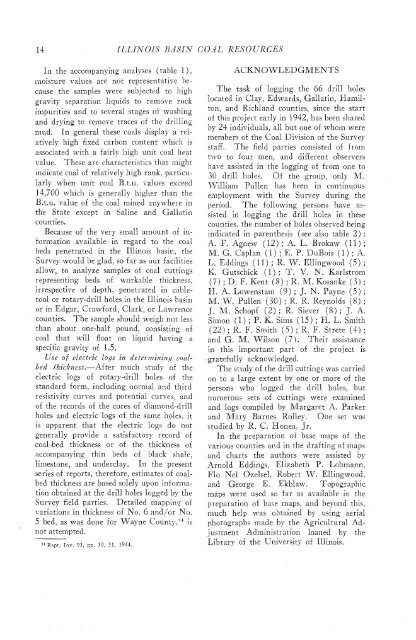subsurface geology and coal resources of the pennsylvanian system ...
subsurface geology and coal resources of the pennsylvanian system ...
subsurface geology and coal resources of the pennsylvanian system ...
You also want an ePaper? Increase the reach of your titles
YUMPU automatically turns print PDFs into web optimized ePapers that Google loves.
14 ILLINOiS BASIN COAL RESOURCES<br />
In <strong>the</strong> accompanying analyses (table 1 ) ,<br />
moisture values are not representative because<br />
<strong>the</strong> samples were subjected to high<br />
gravity separation liquids to remove rock<br />
impurities <strong>and</strong> to several stages <strong>of</strong> washing<br />
<strong>and</strong> drying to remove traces <strong>of</strong> <strong>the</strong> drilling<br />
mud. In general <strong>the</strong>se <strong>coal</strong>s display a relatively<br />
high fixed carbon content which is<br />
associated with a fairly high unit <strong>coal</strong> heat<br />
value. These are characteristics that might<br />
indicate <strong>coal</strong> <strong>of</strong> relatively high rank, particularly<br />
when unit <strong>coal</strong> B.t.u. values exceed<br />
14,700 which is generally higher than <strong>the</strong><br />
B.t.u. value <strong>of</strong> <strong>the</strong> <strong>coal</strong> mined anywhere in<br />
<strong>the</strong> State except in Saline <strong>and</strong> Gallatin<br />
counties.<br />
Because <strong>of</strong> <strong>the</strong> very small amount <strong>of</strong> information<br />
available in regard to <strong>the</strong> <strong>coal</strong><br />
beds penetrated in <strong>the</strong> Illinois basin, <strong>the</strong><br />
Survey would be glad, so far as our facilities<br />
allow, to analyze samples <strong>of</strong> <strong>coal</strong> cuttings<br />
representing beds <strong>of</strong> workable thickness,<br />
irrespective <strong>of</strong> depth, penetrated in cabletool<br />
or rotary-drill holes in <strong>the</strong> Illinois basin<br />
or in Edgar, Crawford, Clark, or Lawrence<br />
counties. The sample should weigh not less<br />
than about one-half pound, consisting <strong>of</strong><br />
<strong>coal</strong> that will float on liquid having a<br />
specific gravity <strong>of</strong> 1.5.<br />
Use <strong>of</strong> electric logs in determining <strong>coal</strong>bed<br />
thick7zess.-After much study <strong>of</strong> <strong>the</strong><br />
electric logs <strong>of</strong> rotary-drill holes <strong>of</strong> <strong>the</strong><br />
st<strong>and</strong>ard form, including normal <strong>and</strong> third<br />
resistivity curves <strong>and</strong> potential curves, <strong>and</strong><br />
<strong>of</strong> <strong>the</strong> records <strong>of</strong> <strong>the</strong> cores <strong>of</strong> diamond-drill<br />
holes <strong>and</strong> electric logs <strong>of</strong> <strong>the</strong> same holes, it<br />
is apparent that <strong>the</strong> electric logs do not<br />
generally provide a satisfactory record <strong>of</strong><br />
<strong>coal</strong>-bed thickness or <strong>of</strong> <strong>the</strong> thickness <strong>of</strong><br />
accompanying thin beds <strong>of</strong> black shale,<br />
limestone, <strong>and</strong> underclay. In <strong>the</strong> present<br />
series <strong>of</strong> reports, <strong>the</strong>refore, estimates <strong>of</strong> <strong>coal</strong>bed<br />
thickness are based solely upon information<br />
obtained at <strong>the</strong> drill holes logged by <strong>the</strong><br />
Survey field parties. Detailed mapping <strong>of</strong><br />
variations in thickness <strong>of</strong> No. 6 <strong>and</strong>/or No.<br />
5 bed, as was done for Wayne County,14 is<br />
not attempted.<br />
*ZRept. Inv. 93, pp. 30, 31, 1941.<br />
The task <strong>of</strong> logging <strong>the</strong> 66 drill holes<br />
located in Clay, Edwards, Gallatin, Hamilton,<br />
<strong>and</strong> Richl<strong>and</strong> counties, since <strong>the</strong> start<br />
<strong>of</strong> this project early in 1942, has been shared<br />
by 24 individuals, all but one <strong>of</strong> whom were<br />
members <strong>of</strong> <strong>the</strong> Coal Division <strong>of</strong> <strong>the</strong> Survey<br />
staff. The field parties consisted <strong>of</strong> from<br />
two to four men, <strong>and</strong> different observers<br />
have assisted in <strong>the</strong> logging <strong>of</strong> from one to<br />
30 drill holes. Of <strong>the</strong> group, only R4.<br />
William Pullen has been in continuous<br />
employment with <strong>the</strong> Survey during <strong>the</strong><br />
period. The following persons have assisted<br />
in logging <strong>the</strong> drill holes in <strong>the</strong>se<br />
counties, <strong>the</strong> number <strong>of</strong> holes observed being<br />
indicated in paren<strong>the</strong>sis (see also table 2) :<br />
A. F. Agnew (12) ; A. L. Brokaw (11);<br />
M. G. Caplan (1); E. P. DuRois (1) ; A.<br />
L. Eddings ( 11 ) ; R. W. Ellingwood (5) ;<br />
K. Gutschick ( 1 ) ; T. V. N. Karlstrom<br />
('7) ; D. F. Kent (8) ; R. M. Kosanke (3);<br />
H. A. Eowenstam (9); J. N. Payne (5);<br />
&/d. W. Pullen (30) ; K. R. Reynolds (8);<br />
J. M. Schopf (2); R. Siever (8) ; J. A.<br />
Simon (1) ; P. K. Sims (15) ; H. L. Smith<br />
(22); R. F. Smith (5); R. F. Strete (4);<br />
<strong>and</strong> G. M. Wilson (7). Their assistance<br />
in this important part <strong>of</strong> <strong>the</strong> project is<br />
gratefully acknowledged.<br />
The study <strong>of</strong> <strong>the</strong> drill cuttings was carried<br />
on to a large extent by one or more <strong>of</strong> <strong>the</strong><br />
persons who logged <strong>the</strong> drill holes, but<br />
numerous sets <strong>of</strong> cuttings were examined<br />
<strong>and</strong> logs compiled by Margaret A. Parker<br />
<strong>and</strong> Mary Barnes Molley. One set was<br />
studied by R. C. Honea, Jr.<br />
In <strong>the</strong> preparation <strong>of</strong> base maps <strong>of</strong> <strong>the</strong><br />
various counties <strong>and</strong> in <strong>the</strong> drafting <strong>of</strong> maps<br />
<strong>and</strong> charts <strong>the</strong> authors were assisted by<br />
Arnold Eddings, Elizabeth P. Lohmann,<br />
Flo Nel Ozelsel, Robert W. Ellingwood,<br />
<strong>and</strong> George E. Ekblaw. Topographic<br />
maps were used so far as available in <strong>the</strong><br />
preparation <strong>of</strong> base maps, <strong>and</strong> beyond this,<br />
much help was obtained by using aerial<br />
photographs made by <strong>the</strong> Agricultural Adjustment<br />
Administration loaned by <strong>the</strong><br />
Library <strong>of</strong> <strong>the</strong> University <strong>of</strong> Illinois.
















